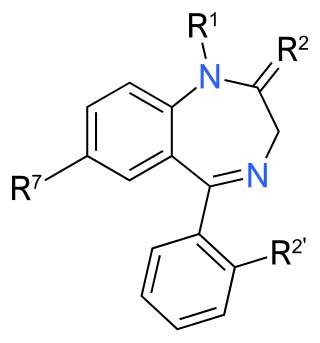Related Research Articles

Dextromethorphan, or DXM, a common active ingredient found in many over-the-counter cough suppressant cold medicines, is used as a recreational drug and entheogen for its dissociative effects. It has almost no psychoactive effects at medically recommended doses. However, dextromethorphan has powerful dissociative properties when administered in doses well above those considered therapeutic for cough suppression. Recreational use of DXM is sometimes referred to in slang form as "robo-tripping", whose prefix derives from the Robitussin brand name, or "Triple Cs", which derives from the Coricidin brand whose tablets are printed with "CC+C" for "Coricidin Cough and Cold". However, this brand presents additional danger when used at recreational doses due to the presence of chlorpheniramine.

Ketamine is a dissociative anesthetic used medically for induction and maintenance of anesthesia. It is also used as a treatment for depression and pain management. It is a novel compound that was derived from phencyclidine in 1962 in pursuit of a safer anesthetic with fewer hallucinogenic effects.
Psychosis is a condition of the mind that results in difficulties determining what is real and what is not real. Symptoms may include delusions and hallucinations, among other features. Additional symptoms are incoherent speech and behavior that is inappropriate for a given situation. There may also be sleep problems, social withdrawal, lack of motivation, and difficulties carrying out daily activities. Psychosis can have serious adverse outcomes.

Phencyclidine or phenylcyclohexyl piperidine (PCP), also known in its use as a street drug as angel dust among other names, is a dissociative anesthetic mainly used recreationally for its significant mind-altering effects. PCP may cause hallucinations, distorted perceptions of sounds, and violent behavior. As a recreational drug, it is typically smoked, but may be taken by mouth, snorted, or injected. It may also be mixed with cannabis or tobacco.

Recreational drug use is the use of one or more psychoactive drugs to induce an altered state of consciousness, either for pleasure or for some other casual purpose or pastime. When a psychoactive drug enters the user's body, it induces an intoxicating effect. Recreational drugs are commonly divided into three categories: depressants, stimulants, and hallucinogens.

Psychopharmacology is the scientific study of the effects drugs have on mood, sensation, thinking, behavior, judgment and evaluation, and memory. It is distinguished from neuropsychopharmacology, which emphasizes the correlation between drug-induced changes in the functioning of cells in the nervous system and changes in consciousness and behavior.

Club drugs, also called rave drugs or party drugs, are a loosely defined category of recreational drugs which are associated with discothèques in the 1970s and nightclubs, dance clubs, electronic dance music (EDM) parties, and raves in the 1980s to today. Unlike many other categories, such as opiates and benzodiazepines, which are established according to pharmaceutical or chemical properties, club drugs are a "category of convenience", in which drugs are included due to the locations they are consumed and/or where the user goes while under the influence of the drugs. Club drugs are generally used by adolescents and young adults.
Dissociatives, colloquially dissos, are a subclass of hallucinogens which distort perception of sight and sound and produce feelings of detachment – dissociation – from the environment and/or self. Although many kinds of drugs are capable of such action, dissociatives are unique in that they do so in such a way that they produce hallucinogenic effects, which may include dissociation, a general decrease in sensory experience, hallucinations, dream-like states or anesthesia. Despite most dissociatives' main mechanism of action being tied to NMDA receptor antagonism, some of these substances, which are nonselective in action and affect the dopamine and/or opioid systems, may be capable of inducing more direct and repeatable euphoria or symptoms which are more akin to the effects of typical "hard drugs" or common drugs of abuse. This is likely why dissociatives are considered to be addictive with a fair to moderate potential for abuse, unlike psychedelics. Despite some dissociatives, such as phencyclidine (PCP) possessing stimulating properties, most dissociatives seem to have a general depressant effect and can produce sedation, respiratory depression, nausea, disorientation, analgesia, anesthesia, ataxia, cognitive and memory impairment as well as amnesia.
Stimulant psychosis is a mental disorder characterized by psychotic symptoms. It involves and typically occurs following an overdose or several day 'binge' on psychostimulants; however, one study reported occurrences at regularly prescribed doses in approximately 0.1% of individuals within the first several weeks after starting amphetamine or methylphenidate therapy. Methamphetamine psychosis, or long-term effects of stimulant use in the brain, depend upon genetics and may persist for some time.

Dizocilpine (INN), also known as MK-801, is a pore blocker of the NMDA receptor, a glutamate receptor, discovered by a team at Merck in 1982. Glutamate is the brain's primary excitatory neurotransmitter. The channel is normally blocked with a magnesium ion and requires depolarization of the neuron to remove the magnesium and allow the glutamate to open the channel, causing an influx of calcium, which then leads to subsequent depolarization. Dizocilpine binds inside the ion channel of the receptor at several of PCP's binding sites thus preventing the flow of ions, including calcium (Ca2+), through the channel. Dizocilpine blocks NMDA receptors in a use- and voltage-dependent manner, since the channel must open for the drug to bind inside it. The drug acts as a potent anti-convulsant and probably has dissociative anesthetic properties, but it is not used clinically for this purpose because of the discovery of brain lesions, called Olney's lesions (see below), in laboratory rats. Dizocilpine is also associated with a number of negative side effects, including cognitive disruption and psychotic-spectrum reactions. It inhibits the induction of long term potentiation and has been found to impair the acquisition of difficult, but not easy, learning tasks in rats and primates. Because of these effects of dizocilpine, the NMDA receptor pore blocker ketamine is used instead as a dissociative anesthetic in human medical procedures. While ketamine may also trigger temporary psychosis in certain individuals, its short half-life and lower potency make it a much safer clinical option. However, dizocilpine is the most frequently used uncompetitive NMDA receptor antagonist in animal models to mimic psychosis for experimental purposes.

Deliriants are a subclass of hallucinogen. The term was coined in the early 1980s to distinguish these drugs from psychedelics such as LSD and dissociatives such as ketamine, due to their primary effect of causing delirium, as opposed to the more lucid and less disturbed states produced by other types of hallucinogens. The term generally refers to anticholinergic drugs, which are substances that inhibit the function of the neurotransmitter acetylcholine. Common examples of deliriants include plants of the genera Datura and Brugmansia as well as higher than recommended dosages of diphenhydramine (Benadryl). A number of plant deliriants such as that of the Solanaceae family, particularly in the Americas have been used by some indigenous cultures to reach delirious and altered states for traditions or rituals, such as rites of passage, divination or communicating with the ancestors. Despite their long history of use, deliriants are the least-studied class of hallucinogens in terms of their behavioral and neurological effects.

Hallucinogen persisting perception disorder (HPPD) is a non-psychotic disorder in which a person experiences apparent lasting or persistent visual hallucinations or perceptual distortions after a previous use of drugs, including but not limited to psychedelics, dissociatives, entactogens, tetrahydrocannabinol (THC), and SSRIs. Despite being designated as a hallucinogen-specific disorder, the specific contributory role of psychedelic drugs is unknown.

Dextromethorphan (DXM) is a cough suppressant used in many cough and cold medicines. It affects serotonin, norepinephrine, NMDA, and sigma-1 receptors in the brain, all of which have been implicated in the pathophysiology of depression. In 2022, the FDA approved the combination dextromethorphan/bupropion to serve as a rapid acting antidepressant in patients with major depressive disorder.

NMDA receptor antagonists are a class of drugs that work to antagonize, or inhibit the action of, the N-Methyl-D-aspartate receptor (NMDAR). They are commonly used as anesthetics for human and non-human animals; the state of anesthesia they induce is referred to as dissociative anesthesia.

Esketamine, also known as (S)-ketamine or S(+)-ketamine, is the S(+) enantiomer of ketamine. It is a dissociative hallucinogen drug used as a general anesthetic and as an antidepressant for treatment of depression. It is sold under the brand names Spravato, Ketanest, among others. Esketamine is the active enantiomer of ketamine in terms of NMDA receptor antagonism and is more potent than racemic ketamine.
Hallucinogens are a large and diverse class of psychoactive drugs that can produce altered states of consciousness characterized by major alterations in thought, mood, and perception as well as other changes. Most hallucinogens can be categorized as either being psychedelics, dissociatives, or deliriants.

Benzodiazepine use disorder (BUD), also called misuse or abuse, is the use of benzodiazepines without a prescription and/or for recreational purposes, which poses risks of dependence, withdrawal and other long-term effects. Benzodiazepines are one of the more common prescription drugs used recreationally. When used recreationally benzodiazepines are usually administered orally but sometimes they are taken intranasally or intravenously. Recreational use produces effects similar to alcohol intoxication.
Substance-induced psychosis is a form of psychosis that is attributed to substance intoxication. It is a psychosis that results from the effects of chemicals or drugs. Various psychoactive substances have been implicated in causing or worsening psychosis in users.
Amphetamine type stimulants (ATS) are a group of synthetic drugs that are chemical derivatives of the parent compound alpha-methylphenethylamine, also known as amphetamine. Common ATS includes amphetamine, methamphetamine, ephedrine, pseudoephedrine, 3,4-methylenedioxymethamphetamine (MDMA), 3,4-methylenedioxyamphetamine (MDA) and 3,4-methylenedioxyethylamphetamine (MDEA). ATS when used illicitly has street names including ice, meth, crystal, crank, bennies, and speed. Within the group of amphetamine-type stimulants, there are also prescription drugs including mixed amphetamine salts, dextroamphetamine, and lisdexamfetamine.
Ketamine has had a wide variety of medicinal and recreational uses since its discovery in 1962.
References
- ↑ Wood, Dan; Cottrell, Angela; Baker, Simon C.; Southgate, Jennifer; Harris, Maya; Fulford, Simon; Woodhouse, Christopher; Gillatt, David (June 2011). "Recreational ketamine: from pleasure to pain: RECREATIONAL KETAMINE". BJU International. 107 (12): 1881–1884. doi:10.1111/j.1464-410X.2010.10031.x. PMID 21314885. S2CID 44450934.
- 1 2 3 Muetzelfeldt, L.; Kamboj, S. K.; Rees, H.; Taylor, J.; Morgan, C. J. A.; Curran, H. V. (2008-06-01). "Journey through the K-hole: Phenomenological aspects of ketamine use". Drug and Alcohol Dependence. 95 (3): 219–229. doi:10.1016/j.drugalcdep.2008.01.024. ISSN 0376-8716. PMID 18355990.
- ↑ "Ketamine". Bristol Drug Project. Retrieved 2022-05-17.
- 1 2 3 4 5 Stirling, John; McCoy, Lauren (December 2010). "Quantifying the psychological effects of ketamine: from euphoria to the k-hole". Substance Use & Misuse. 45 (14): 2428–2443. doi:10.3109/10826081003793912. ISSN 1532-2491. PMID 21039109. S2CID 207520095.
- ↑ Rosenbaum, Steven B.; Gupta, Vikas; Palacios, Jorge L. (2022), "Ketamine", StatPearls, Treasure Island (FL): StatPearls Publishing, PMID 29262083 , retrieved 2022-05-17
- ↑ "We Asked People About the K-Holes That Changed Their Lives". www.vice.com. Retrieved 2022-05-17.
- ↑ Curran, H V; Monaghan, L (2001-05-01). "In and out of the K-hole: a comparison of the acute and residual effects of ketamine in frequent and infrequent ketamine users". Addiction. 96 (5): 749–760. doi: 10.1046/j.1360-0443.2001.96574910.x . ISSN 1360-0443. PMID 11331033.
- ↑ Zuccoli, M. L.; Muscella, A.; Fucile, C.; Carrozzino, R.; Mattioli, F.; Martelli, A.; Orengo, S. (August 2014). "Paliperidone for the Treatment of Ketamine-Induced Psychosis: A Case Report". The International Journal of Psychiatry in Medicine. 48 (2): 103–108. doi:10.2190/PM.48.2.c. ISSN 0091-2174. PMID 25377151. S2CID 37137378.
- ↑ "British Library". www.bl.uk. Retrieved 2022-05-17.
- ↑ Morgan, Celia J. A.; Curran, H. Valerie; Independent Scientific Committee on Drugs (January 2012). "Ketamine use: a review". Addiction. 107 (1): 27–38. doi:10.1111/j.1360-0443.2011.03576.x. ISSN 1360-0443. PMID 21777321.